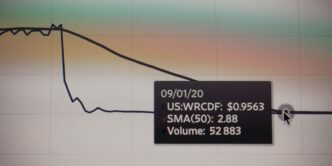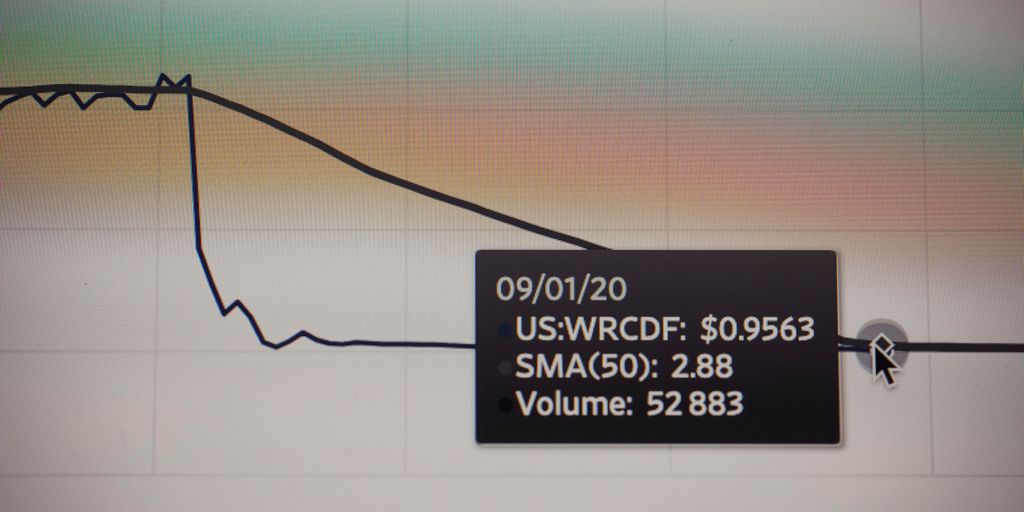Thinking about investing in the NASDAQ 100? You’ve probably heard of QQQ, but there’s another player in town: qqqm stock. This one is a bit newer and designed for long-term investors looking for a cost-effective way to get into those big-name tech and growth companies. We’ll break down what qqqm stock is all about, how it stacks up against its older sibling QQQ, and what you should think about before putting your money into it.
Key Takeaways
- QQQM stock offers a lower expense ratio compared to QQQ, making it cheaper to hold over time.
- QQQM is structured as an ETF, which gives it more flexibility than QQQ’s Unit Investment Trust structure.
- Both QQQM and QQQ track the NASDAQ 100 Index, focusing on large non-financial companies.
- QQQM is generally better suited for long-term investors due to its lower cost and traditional ETF structure.
- While QQQM provides good diversification within the NASDAQ 100, it still has a heavy concentration in the technology sector, which can mean more volatility.
Understanding QQQM Stock: A Comprehensive Overview

What is QQQM Stock?
QQQM, or the Invesco NASDAQ 100 ETF, is an exchange-traded fund designed to mirror the performance of the NASDAQ 100 index. It’s like a basket holding stocks of the 100 largest non-financial companies listed on the Nasdaq. Think of it as a way to invest in a bunch of big tech and growth companies all at once. It’s designed for investors looking to benefit from the performance of leading companies that shape market trends and global economies.
Invesco’s Role in QQQM
Invesco manages QQQM. They’re a big deal in the investment world, known for their ETFs. Invesco aims to give investors efficient and clear ways to invest. They’ve been around a while and have a good reputation. The introduction of QQQM, alongside other specialized products illustrates a broader strategy by Invesco. This “QQQ family” approach leverages the strong brand recognition of QQQ to offer tailored solutions for diverse investor needs.
Key Metrics of QQQM
Understanding the key metrics of QQQM is important for any investor. Here are some things to consider:
- Expense Ratio: This is the annual cost to own the ETF, expressed as a percentage. It’s a key factor in comparing QQQM to similar ETFs.
- Assets Under Management (AUM): This shows the total value of assets managed by the ETF. A higher AUM can indicate greater investor confidence.
- Trading Volume: This indicates how actively the ETF is traded. Higher volume usually means it’s easier to buy and sell shares without affecting the price too much.
- Top Holdings: Knowing the top holdings gives you insight into where your money is actually invested. Common top holdings include tech giants like Apple, Amazon, Microsoft and NVIDIA.
- Sector Allocation: This shows how the ETF’s investments are distributed across different sectors, like technology, healthcare, and consumer discretionary. The QQQM ETF is primarily focused on the technology sector, comprising a significant portion of its holdings.
QQQM Stock Versus QQQ: A Detailed Comparison
Expense Ratio Differences
Okay, so let’s talk about the money, honey! One of the biggest differences between QQQM and QQQ is the expense ratio. QQQM generally has a lower expense ratio than QQQ. This means you’ll pay less in fees each year to own QQQM compared to QQQ. It might not seem like a lot, but over the long haul, those little percentages can really add up. For example:
| ETF | Expense Ratio |
|---|---|
| QQQ | 0.20% |
| QQQM | 0.15% |
So, if you’re super cost-conscious, QQQM is the way to go. It’s like choosing the generic brand at the grocery store – same stuff, less money. This makes it a cost-effective entry into the market.
Structural Variations: UIT vs. ETF
QQQ and QQQM have different structures. QQQ is a Unit Investment Trust (UIT), while QQQM is an Exchange Traded Fund (ETF). What does this mean? Well, a UIT, like QQQ, has some restrictions. For example, QQQ can’t reinvest dividends; it has to distribute them. QQQM, being an ETF, can reinvest dividends, which could lead to slightly better long-term growth. However, in practice, this difference is pretty small. It’s more of a technicality than something that will drastically change your returns.
Liquidity and Trading Volume
When it comes to liquidity and trading volume, QQQ is the clear winner. It’s been around longer and is way more popular, so it trades a lot more shares every day. This means:
- Tighter Bid-Ask Spreads: You’ll probably get a better price when you buy or sell QQQ because there are more buyers and sellers.
- Easier to Buy and Sell Large Quantities: If you’re trading a ton of shares, QQQ can handle it without moving the price too much.
- More Options Activity: If you like trading options, QQQ has a much more active options market.
QQQM is still liquid, but it doesn’t have the same level of trading activity as QQQ. So, if you’re a super active trader or need to move huge amounts of stock, QQQ is probably the better choice. For most regular investors, though, QQQM’s liquidity is just fine. The top holdings are nearly identical.
Investment Strategy and Index Tracking for QQQM Stock
Replicating the NASDAQ 100 Index
QQQM aims to mirror the performance of the NASDAQ-100 Index. It’s pretty straightforward, really. The fund invests in a portfolio designed to match the index’s composition. This means QQQM holds stocks of the 100 largest non-financial companies listed on the Nasdaq. Think of it as a way to get exposure to those big tech names without buying each stock individually. The goal is to provide returns that closely track the index’s ups and downs. It’s a popular choice for investors looking for broad exposure to the tech sector.
Full Replication Strategy
QQQM uses a full replication strategy. This means it invests in all the securities within the NASDAQ-100 Index, and it does so in proportion to their weightings. So, if Apple makes up 8% of the index, QQQM will allocate roughly 8% of its assets to Apple stock. This approach aims to minimize tracking error, which is the difference between the fund’s performance and the index’s performance. It’s a pretty common strategy for ETFs that want to closely mirror an index. It’s worth noting that QQQM’s structure as an open-ended ETF allows for reinvestment of dividends, which can help lower tracking error compared to other structures.
Sector Concentration and Exposure
QQQM, like the NASDAQ-100, is heavily weighted toward the technology sector. This is just a natural consequence of the index it tracks. While it offers diversification within those 100 companies, it’s important to recognize that your investment will be significantly exposed to the performance of tech stocks. Here’s a quick look at typical sector allocations:
- Technology: Dominates the fund, often making up 40-50% of the portfolio.
- Consumer Discretionary: A significant portion, including companies like Amazon.
- Communication Services: Includes companies like Alphabet (Google) and Meta (Facebook).
It’s a good idea to consider this sector concentration when building your overall investment portfolio. If you’re already heavily invested in tech, QQQM might amplify that exposure. If you are looking to invest in your future, make sure you consider all the risks.
Performance and Historical Context of QQQM Stock
QQQM’s Operational Track Record
QQQM is the younger sibling to QQQ, so it naturally has a shorter history. QQQM was created to offer a lower-cost alternative to QQQ while tracking the same NASDAQ 100 index. Because of this, its operational track record is something to consider. It hasn’t been around as long, so we have less data to look at. This doesn’t necessarily mean it’s a bad investment, but it’s something to keep in mind.
Performance Relative to the NASDAQ 100
Since QQQM aims to mirror the NASDAQ 100, its performance should closely align with the index. Any differences are usually due to the expense ratio and slight tracking variations. Over the past year, QQQ has returned around 39%, while QQQM has been closer to 33%. Here’s a quick look at how the two ETFs stack up:
| ETF | 1-Year Return | 5-Year Return |
|---|---|---|
| QQQ | 39.35% | 20.65% |
| QQQM | 32.77% | 18.53% |
It’s worth noting that historical data for QQQM is still being built, so longer-term returns aren’t yet available.
Dividend Distributions of QQQM
Both QQQ and QQQM distribute dividends quarterly, typically in March, June, September, and December. The dividend yield isn’t usually the main draw for these ETFs, as they are more focused on growth. However, the dividends do provide a bit of income for investors. The dividend yield for QQQM is around 0.69%. Keep in mind that these dividends are subject to taxes, which is something to consider when assessing tax considerations for your investment strategy.
Analyzing the Holdings and Sector Exposure of QQQM Stock
Top Non-Financial Companies
QQQM is designed to mirror the NASDAQ 100, so its top holdings are pretty consistent. The ETF focuses on the largest non-financial companies listed on the Nasdaq. You’ll find familiar names dominating the list. As of a recent check, the top holdings include tech giants like Apple, Microsoft, Amazon, and NVIDIA. These companies often make up a significant chunk of the ETF’s overall value.
Dominance of Technology Sector
It’s no secret that QQQM is heavily weighted toward the technology sector. This is because the NASDAQ 100 itself is tech-heavy. This concentration means that QQQM’s performance is closely tied to the performance of the tech industry. While this can lead to strong growth during tech booms, it also means the ETF can be more volatile during tech downturns. Investors should be aware of this sector concentration and how it aligns with their risk tolerance.
Other Key Sector Allocations
While tech is king, QQQM isn’t only tech. You’ll also find allocations to other sectors, though they are smaller. These typically include:
- Consumer Discretionary: Companies that offer non-essential goods and services.
- Healthcare: Pharmaceutical, biotech, and healthcare equipment companies.
- Communication Services: Telecommunications and media companies.
These sectors provide some diversification, but the overall portfolio remains heavily tilted toward technology. For physicians looking for a more cost-effective entry into the tech sector without sacrificing your investment portfolio performance, QQQM offers an appealing alternative to QQQ. Here’s a quick look at how the sectors break down (approximate):
| Sector | Percentage |
|---|---|
| Technology | 50% |
| Consumer Discretionary | 20% |
| Communication Services | 10% |
| Healthcare | 7% |
| Other | 13% |
Keep in mind that these percentages can shift over time as the market changes. Investors often utilize QQQM’s correlation with the tech sector and broader market trends to make informed decisions about portfolio allocation and risk management.
Benefits of Investing in QQQM Stock
Cost-Effective Exposure to Growth Stocks
QQQM offers a pretty neat way to get into growth stocks without breaking the bank. Its lower expense ratio, compared to QQQ, makes it an attractive option for investors who are cost-conscious. Think of it this way: every little bit saved on fees can add up over the long haul, boosting your overall returns. For physicians looking for a more cost-effective entry into the tech sector, QQQM offers an appealing alternative. Plus, you’re getting exposure to some of the biggest names in tech, which have historically shown strong growth potential. It’s a win-win, really.
Diversification Within the NASDAQ 100
Investing in QQQM is like buying a slice of the entire NASDAQ 100 pie. Instead of betting on just one or two companies, you’re spreading your investment across 100 of the largest non-financial companies listed on the NASDAQ. This diversification can help reduce risk. The top holdings in both QQQ and QQQM include tech giants like Apple, Amazon, Broadcom, Microsoft, and NVIDIA. Here’s why that’s cool:
- Reduced Volatility: When one stock dips, others might rise, evening out your portfolio’s performance.
- Exposure to Multiple Sectors: While heavily weighted in tech, the NASDAQ 100 also includes companies from consumer discretionary, healthcare, and other sectors.
- Simplified Investing: Instead of picking individual stocks, you get a diversified portfolio in one easy investment.
Suitability for Long-Term Investors
QQQM is particularly well-suited for those of us playing the long game. If you’re thinking about retirement, or just building wealth over time, QQQM can be a solid choice. Here’s why:
- Growth Potential: The NASDAQ 100 is packed with innovative companies that have the potential for significant growth over the long term.
- Lower Expense Ratio: Over many years, even a small difference in expense ratios can translate to substantial savings.
- Reinvestment Opportunities: Dividends are reinvested, allowing your investment to compound over time. This approach caters more to long-term, buy-and-hold retail investors. The QQQ family approach leverages the strong brand recognition of QQQ to offer tailored solutions for diverse investor needs.
Considerations and Risks of QQQM Stock
Market Volatility and Concentration Risk
Investing in QQQM, while offering exposure to the NASDAQ 100, isn’t without its risks. The fund’s performance is closely tied to the tech sector, making it susceptible to market volatility and sector-specific downturns. Because QQQM concentrates its holdings in a relatively small number of companies, a significant decline in one or more of these top holdings can have a substantial impact on the fund’s overall value. Diversification can help mitigate single stock risk, but it’s important to understand the fund’s concentration before investing.
Impact of Interest Rate Changes
Changes in interest rates can affect QQQM, particularly because many of the companies within the NASDAQ 100 are growth-oriented. Higher interest rates can lead to increased borrowing costs for these companies, potentially impacting their profitability and stock prices. Additionally, rising interest rates can make bonds more attractive to investors, potentially leading to a shift away from stocks, including those held by QQQM. Keep an eye on economic indicators and Federal Reserve policy announcements to gauge the potential impact of interest rate changes on your QQQM investment.
Comparison with Broader Market ETFs
QQQM provides focused exposure to the NASDAQ 100, which is heavily weighted towards technology. While this can lead to strong performance during tech booms, it also means QQQM may underperform broader market ETFs like those tracking the S&P 500 during periods when other sectors are leading the market. Here are a few points to consider:
- QQQM’s performance is less diversified than broader market ETFs.
- QQQM may experience higher volatility due to its sector concentration.
- QQQM’s returns may deviate significantly from the overall market during sector rotations.
Conclusion
So, there you have it. QQQM is a pretty solid choice if you’re looking to get into the NASDAQ 100 without paying as much as you would for QQQ. It’s newer, sure, but it tracks the same big-name tech and growth companies. For folks who plan to hold onto their investments for a while, that lower fee really adds up over time. Just remember, even though it’s a good option, it’s still smart to think about how it fits into your whole investment plan. Don’t just jump in without a little thought, okay?
Frequently Asked Questions
What exactly is QQQM Stock?
QQQM is an exchange-traded fund (ETF) from Invesco that aims to copy the performance of the NASDAQ 100 Index. It’s like buying a little piece of 100 big, non-financial companies listed on the Nasdaq, all in one go.
How does Invesco fit into QQQM?
QQQM was created by Invesco, a large company that manages money for people and businesses. They are known for making ETFs, and QQQM is their way to offer a cheaper version of their popular QQQ fund, aiming for long-term investors.
What are the main differences between QQQM and QQQ?
The main difference is cost and structure. QQQM has a lower yearly fee (expense ratio) than QQQ, making it cheaper to hold for a long time. Also, QQQM is a regular ETF, which is more flexible with dividends and taxes than QQQ, which is an older type of fund called a Unit Investment Trust.
What kinds of companies does QQQM invest in?
QQQM mostly invests in big technology companies, but it also includes companies from other areas like consumer products and healthcare. It doesn’t include banks or other financial companies.
Is QQQM a good investment for me?
QQQM can be a good choice for people who want to invest in many strong, growing companies on the Nasdaq without buying each stock separately. It’s also good for long-term investors because of its lower fees. However, remember that tech stocks can go up and down a lot.
What are the risks of investing in QQQM?
Like any investment, QQQM has risks. Because it focuses on the Nasdaq 100, which has many tech companies, its value can change a lot if the tech market is shaky. Also, changes in interest rates can affect these types of growth companies.













